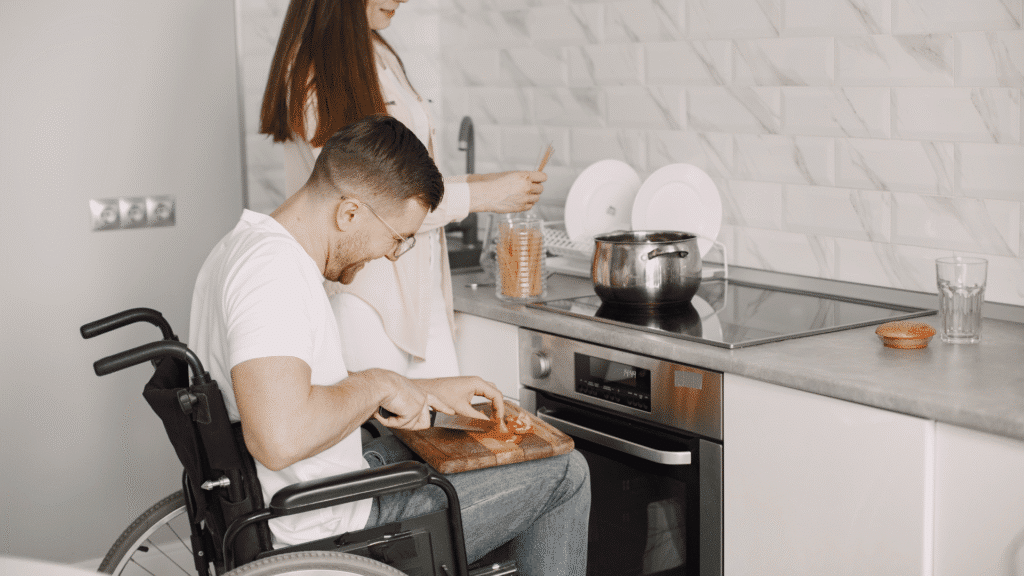In this article:
- When and why the NDIS funds home modifications
- What’s usually covered (and what’s not)
- Real examples of home changes that are generally approved
- What evidence you’ll need for your claim
- How Plan Hero can make the process easier
If you’re trying to make your home safer or more accessible, it can be hard to know what the NDIS will actually fund. Questions like “Will the NDIS pay for my bathroom renovation?” or “Can I get a ramp installed through my plan?” are common.
At Plan Hero, we help you make sense of these questions every day. While we don’t make NDIS funding decisions, our Plan Managers can guide you as to what is included in your NDIS plan.
Here’s a straight-forward guide to what’s covered, what’s not, and how to approach home modifications in your plan.
What does the NDIS mean by “Home Modifications”?
Home Modifications are a Capital Support and so you will need funding in this part of your NDIS plan.. This means they’re considered an investment — a change to your physical environment that helps you live more safely and independently.
They can include:
- Assessments, design reports and supervision by qualified builders or occupational therapists
- Installation or construction work to make your home more accessible (for example, widening doors, installing ramps, or creating level access showers)
Home modifications are only funded when they’re reasonable and necessary — in other words, directly related to your disability, not general renovations that anyone might choose.
When will the NDIS fund home modifications?
The NDIS may fund home modifications when:
- You own your home, or your landlord has given written consent for the changes
- An occupational therapist (OT) recommends the modification after assessing your needs
- The work is safe, meets NDIS building standards, and offers value for money compared with other options
If you rent, your landlord must agree in writing before any work starts. The NDIS won’t fund modifications if the property owner doesn’t consent or if the modification isn’t essential for disability access.
Will the NDIS fund a bathroom renovation?
Yes, if it’s needed for accessibility or safety.
The NDIS often funds these types of changes to your bathroom:
- Removing a bathtub to install an open (walk-in or roll-in) shower
- Installing grab rails beside the shower, toilet or bath
- Adding handheld shower hoses or non-slip flooring
- Widening the door for wheelchair or walker access
Decorative work like retiling, painting or luxury fittings are not covered unless they’re part of the functional modification.
Standard bathrooms for comfort or style reasons aren’t funded under the NDIS, as they’re considered general home improvements.
Will the NDIS fund kitchen modifications for accessibility?
The NDIS may fund kitchen modifications when your disability prevents you from using your kitchen safely or independently. Examples include:
- Lowered benchtops or sinks for wheelchair users
- Pull-out or adjustable cupboards
- Accessible tapware or controls that reduce reach or strength demands
The NDIS won’t fund new appliances, cabinetry upgrades, or aesthetic improvements unrelated to function. These are considered household upgrades rather than disability supports.
Will the NDIS fund door widening?
Yes, this is one of the most common and straightforward home modifications funded by the NDIS.
Widening internal or external doorways helps participants who use wheelchairs or mobility aids move freely through their home.
To be approved, an OT usually needs to confirm that the change is necessary for daily living and can’t be met by a simpler, lower-cost option.
Will the NDIS fund ramps?
Fixed or portable ramps may be funded when they allow safe access in and out of your home, or between levels.
Ramps need to meet Australian safety standards and be designed by a professional to suit your mobility equipment.
If a portable ramp is a better fit, it might be funded as assistive technology rather than a structural home modification, but it is still under the Capital Supports category.
Will the NDIS fund stairlifts or platform lifts?
Funding for stairlifts or vertical platform lifts may be possible when:
- You can’t safely use stairs because of your disability, and
- Moving to a single-level home isn’t reasonable or possible, and
- A qualified OT has recommended it as essential for daily access
Because lifts are high-cost capital items, they require a formal quote, structural review, and NDIA approval before installation.
The NDIS generally won’t fund lifts used for convenience or where an alternative, like living on one level, would meet your needs more economically.
Will the NDIS fund air conditioning or heating systems?
No, standard air conditioning and heating systems are considered everyday household expenses.
In rare cases, funding may be approved if your disability affects your ability to regulate temperature. For example, some participants with spinal cord injuries or certain neurological conditions may need controlled environments to stay safe. In those cases, you’ll need medical evidence showing the health risk and the system’s direct link to your disability.
Will the NDIS fund ceiling fans?
No. Ceiling fans are standard household fixtures and not considered disability-related.
But like air conditioning, if a ceiling fan helps manage a diagnosed temperature regulation issue and is recommended by a clinician, funding may be considered as part of an assistive technology request.
Will the NDIS fund security cameras or video doorbells?
The NDIS does not fund home security for general safety or crime prevention — these are considered everyday homeowner costs.
However, funding may be possible where the device directly supports a disability-related need. For example:
- A video doorbell for a person who is deaf or hard of hearing, so they can see who is at the door
- A visual alert system to replace an auditory signal
If there’s a clear functional link to your disability and it supports independence or safety, it can be considered a reasonable and necessary support.
Will the NDIS fund toilets with bidet or wash functions?
Yes, these are often funded when they support hygiene and dignity for participants with mobility or continence issues.
The NDIS usually funds the base-level bidet function, not premium or comfort features like seat warmers or lighting.
You’ll need supporting evidence from an OT or continence nurse explaining why it’s required for daily personal care.
Will the NDIS fund non-slip flooring?
Yes, if the modification helps you move safely around your home and reduces the risk of falls.
The NDIS typically funds non-slip flooring where a participant uses mobility aids or has balance limitations. Cosmetic flooring upgrades, however, are not covered.
What won’t the NDIS fund when it comes to your home?
The NDIS does not fund day-to-day living or homeownership costs.
Examples of these include:
- General maintenance, painting, or cosmetic upgrades
- New kitchens or bathrooms not linked to disability needs
- Pools, spas, and garden landscaping
- Energy systems like solar panels or generators
- Utilities such as water, electricity, or gas bills
- Home security unrelated to disability
In short, if it’s something any homeowner would normally pay for, the NDIS is unlikely to fund it.
How does the NDIS decide if something is “reasonable and necessary”?
The NDIA looks at several factors, including:
- Whether the support is directly related to your disability
- Whether it helps you pursue your goals and participate more fully in daily life
- Whether it offers good value for money
- Whether it’s most appropriately funded through the NDIS, not another service system (like housing or health)
Your occupational therapist’s report is crucial here — it should clearly explain how the modification supports your independence and safety.
You can read more about reasonable and necessary here
How can Plan Hero help with home modification funding?
At Plan Hero, we know these decisions aren’t simple. You might have quotes ready, but still wonder if the NDIS will pay for them — or you might be waiting for a report before you start.
Our Plan Managers can help by:
- Checking that your quotes and invoices meet NDIS claiming requirements
- Making sure your modifications are claimed under the correct Capital Support category
- Liaising with your OT or provider (with your consent) to clarify documentation
- Tracking your remaining budget so you can plan ahead with confidence
We don’t coordinate or organise modifications ourselves — that’s the role of your Support Coordinator or OT — but we make sure the financial side runs smoothly so there are no surprises. With the right plan management support, you can focus on creating a home that works for you, without the stress of figuring out if the NDIS will pay for it.
References:
- NDIS Pricing Arrangements and Price Limits 2025–26
- Supports that are NDIS supports (ndis.gov.au)
- Supports that are not NDIS supports (ndis.gov.au)




